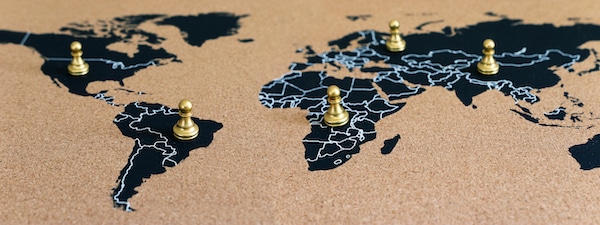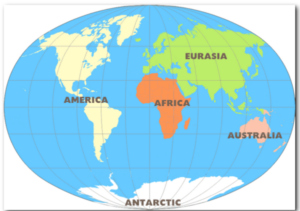by Nick Giambruno, International Man:

The rules-based international order…
The liberal international order…
The international community…
You undoubtedly have heard the media and politicians use these strange and vague phrases.
They describe the current world order or architecture for international political relations between countries.
TRUTH LIVES on at https://sgtreport.tv/
World orders are nothing new. It’s how the big global powers have set the rules of the game for centuries.
On a smaller scale, it’s similar to when the most powerful criminal groups in a given city—like mafias and street gangs—come together and agree on how to divide their activities and neighborhoods among themselves.
Sooner or later, though, these agreements always break down. Then, there is a violent power struggle until the criminal groups reach a new agreement reflecting the new power balance.
A similar dynamic is at play with the most powerful countries and world orders.
Wars among the most powerful countries typically lead to a breakdown and restructuring in the world order.
Here is a brief overview of some of the most recent world orders.
You can think of them as epochs or distinctive historical periods reflecting the shifting power balance among global players.
Congress of Vienna (1814 to 1914): The military defeat of French Emperor Napoleon I led to this world order. It enshrined the British as the dominant global power. The Congress of Vienna formed the basis for European international politics until the outbreak of World War I in 1914.
Treaty of Versailles (1919 to 1939): The victors of World War I created this world order, which featured institutions like the League of Nations. It broke down after Germany and Japan tried to make their own world order during World War II.
The Current US-Led World Order (1945 to Today): The Allies crafted the current world order in the aftermath of World War II with the US as the leader. It features institutions like the United Nations, the World Bank, and the International Monetary Fund—all located in the US. As a result, the current world order has been largely unipolar, with the US exercising significant influence over international policies and decision making.
Today, it’s evident global power is shifting as the current US-led world order is breaking down at an accelerating pace.
Changes to the world order are historical events with enormous implications.
That’s why it’s crucial to sift through the noise and propaganda to put the pieces together correctly to see the true Big Picture.
Having a correct understanding of geopolitics is crucial.
Geopolitics
The founding figure of geopolitical thought was British strategist Sir Halford Mackinder. He created a broad theory that linked geography to global power. Even today, military experts in the United States, Russia, and China continue to examine his ideas.
According to Mackinder, the secret to becoming the world’s foremost power was to control the vast expanse of land comprising Asia and Europe, known as Eurasia.

Source: Free World Maps
Zbigniew Brzezinski, a prominent American geopolitical strategist, also emphasized the significance of Eurasia in his book, The Grand Chessboard: American Primacy and Its Geostrategic Imperatives. He agreed with Mackinder’s views on the crucial role of the Eurasian region.
“Ever since the continents started interacting politically, some five hundred years ago, Eurasia has been the center of world power. A power that dominates ‘Eurasia’ would control two of the world’s three most advanced and economically productive regions… rendering the Western Hemisphere and Oceania geopolitically peripheral to the world’s central continent. About 75% of the world’s people live in ‘Eurasia,’ and most of the world’s physical wealth is there as well, both in its enterprises and underneath its soil. ‘Eurasia’ accounts for about three-fourths of the world’s known energy resources.”
If one country—or alliance—could gain control over Eurasia’s resources, it would become an unstoppable global superpower… one that would upend the current US-led world order.
Ensuring this doesn’t happen has been the core objective of US foreign policy. However, it is often unmentioned or thinly disguised with ridiculous propaganda about spreading democracy, fighting the Hitler du jour, or protecting human rights.
This is the Big Picture context in which we should view recent and more historical events—NATO expansion, the Russian invasion of Ukraine, the wars in Afghanistan and Iraq, the rise of China, etc.
In short, the primary geopolitical objective of the US has been to keep Eurasia subordinated, dependent, divided, and weak.
Zooming out, here is a high-level overview of Eurasia.
- Europe is subordinate to and dependent on the US. The European Union, NATO, and the presence of US military bases ensure most Europeans don’t exercise any real independence.
- The US has been unable to subdue the Middle East—notably Iran and its allies—so the next best thing is to keep the region divided and in perpetual turmoil.
- Many decades after World War II and the Korean War, the US military still occupies Japan and South Korea, two Asian economic powerhouses. That keeps them tethered to the US geopolitically.
- Aside from Russia and China, most of the rest of the Eurasian countries are up for grabs and arenas for geopolitical competition.
Here is one sure thing. The US is bungling basic geopolitical strategy.
From the US perspective, the optimal strategy would be to pit Russia and China against each other, which the US successfully did to help win the Cold War. Instead, US actions today are pushing China and Russia closer together, which creates a credible challenge to the US-led order.
Here’s the bottom line.
We are approaching the end of an era. The current world order is getting shaky and could soon fall apart. A dangerous power struggle is already going on, and it could become catastrophic if it comes to an open war between the big powers.
I’m not trying to be a referee and say who the good and bad guys are. But, frankly, they are all bad guys, not unlike a collection of crime families dividing up the spoils of a given city—except on a global level.
I’m just trying to objectively describe the Big Picture to make better-informed investment decisions in what could be the most volatile time in anyone’s life.
A Multipolar World Order
Russia, China, and Iran are the primary Eurasian geopolitical challengers to the US-led world order.

While they resent US dominance, Russia and China have a seat at the table in the current US-led world order as junior members. They have permanent seats at the UN Security Council and are members of core international organizations like the IMF, the World Bank, the WTO, etc.
Further, China and Russia are the only countries with sophisticated enough nuclear arsenals to go toe-to-toe with the US up to the top of the military escalation ladder, a concept to describe how the severity of a military conflict can increase.
In other words, the US military can’t attack Russia and China with impunity because they can match each move up to all-out nuclear war—the very top of the military escalation ladder.
Read More @ InternationalMan.com



